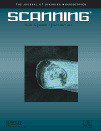Fluorescence Quenching by Colloidal Heavy Metals Nanoparticles: Implications for Correlative Fluorescence and Electron Microscopy Studies
Abstract
Labels for correlative immunolabeling in light (LM) and electron microscopy (EM) employing colloidal metal nanoparticles (gold or palladium) and fluorescent dyes (Alexa Fluor, AF) were investigated. The fluorescence signals from direct conjugates (cAu-IgG-AF) and from an indirect label system (cAu-IgG-anti IgG-AF) were studied using scanning spectrofluorometry and fluorescence light microscopy.
Direct conjugation of protein—AF, IgG-AF or FGN-AF to 18 and 5 nm colloidal gold (cAu18 and cAu5) or 12 nm colloidal palladium particles (cPd12) resulted in nearly completely quenched fluorescence signals (>99 %) at excitation wavelengths of 488, 546 and 594 nm. In contrast, indirect conjugation, when colloidal metal particles and AF were conjugated to primary or secondary antibody, respectively (cAu-IgG-antiIgG-AF), sufficient fluorescence signal was detected.
Commercially available conjugates, consisting of IgG-AF-cAu5 and IgG-AF-cAu10, were also tested and proved to be a mixture of IgG-AF (unbound to cAu) and cAu-IgG-AF. SCANNING 29: 000-V000, 2007. © 2007 Wiley Periodicals, Inc.




